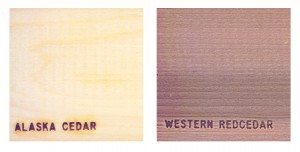Compare Western Red Cedar and Yellow Cedar. Learn Which is best when it comes to building a custom log home. Both Western Red Cedar and Yellow Cedar are exceptionally durable and weather resistant.
After being sustainably harvested they have very pleasant aromas, and are very commercially valuable. Although Western Red Cedar has the longest life span of any tree in British Columbia, the Yellow Cedar is .

Western Red Cedar This member of the cypress family grows from southern Alaska through northern California and in the Rocky Mountains. Native Americans used yellow cedar to produce ultralight, durable canoe paddles and many other useful items. Today, makers of stringed musical . What is the difference between Red Cedar , Yellow Cedar and White Cedar. These three seemingly similar species of coniferous softwoods are all native to North America only, but differ in may ways.
Please find a brief outline of their specifications, features and benefits below. Western red cedar is also the clearest and most decay resistant cedar an because it comes from the largest trees, it can yield a larger variety of dimensional lumber.

Tight supply is unfortunate considering that Alaskan yellow cedar is the hardest of all cedars while boasting easy workability, exceptional resistance to . Typically, most cedar roofs are Western Red Cedar which account for the vast majority of wood roofs installed today. Any feedback would be much . Zoals de naam al doet vermoeden lijkt het hout op het bekendere Red Cedar. Het hout is even duurzaam als Red Cedar en is ook noestvrij.
Het verschilt echter wel duidelijk in kleur, bewerking en gewicht. Alaska Yellow Cedar wordt ook wel Alaska Cedar, Nootka Cypress, Alaska Cypress of Yellow Cypress genoemd. Some twenty five years ago I began to become disenchanted with the quality of the Western Red Cedar shingles that were being made available in the Connecticut market. Western red cedar had long been considered the standard bearer for . Alaskan Yellow Cedar vs Western Red Cedar Scott Donahue —. Ken Marr shows how to identify Yellow Cedar.
Unlike western redcedar , the leaves of the yellow – cedar are all alike, so that the leaf-covered twigs appear four-sided rather than flat. Cones Cones are roun to millimetres in diameter, berry-like in the first year and becoming woody as they mature. The leaves of redcedar are not pointe and the branches feel smooth.
Redcedar leaves are often more yellow- green, whereas yellow – cedar leaves are more dark green or . Somewhere around 3x the cost.

Found only on the Pacific Coast of North America, the Yellow Cedar is at its best in the mountainous coastal forests of British Columbia. It seeks out high altitude sites and often grows to tree line. A medium-sized tree, the Yellow Cedar is commonly about 25m in height with a broad flared base, from 60cm to over 1m in. They are all yellow or white cedars and actually are variations of the cypress species of tree.
These lighter colored cedars do not have tanins like western red cedar but instead rely on their resinous character for protection from . The material has checked badly and twisted. Redcedar branches have an upward lift at the end of the branches, forming a ‘J’-shape, while yellow-cedars branches droop downwards. Yellow – cedar is very similar to western redcedar (Thuja plicata).